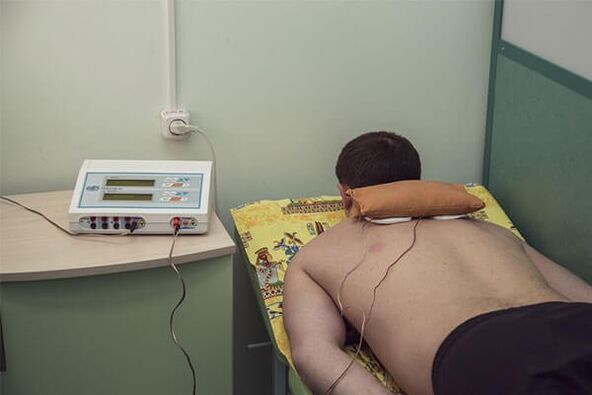Osteochondrosis is a degenerative-dystrophic disorder in the intervertebral joint cartilage, causing deformation and destruction.Osteochondrosis can develop in one or more spine.Osteochondrosis of the cervical areaIt occurs mainly, and sometimes provides very serious complications.

Characteristics of cervical spinal osteochondrosis
Due to the features of the cervical spine structure, courses and symptoms of osteochondrosis in this segment have several features.The cervical bone is made up of small moving vertebrae, which is always subject to significant and long load.The vertebral canal in the cervical region is the narrowest, so the spinal cord compression in this segment develops more frequently and leads to relatively serious lesions.In the neck there is a large accumulation of nerves and blood vessels, including the vertebral artery, which provides cerebellum nutrition, oval and back brain.Violation of blood flow in this artery leads to violations of coordination, dizziness, reduction in vision and hearing, and in severe cases, stroke may develop.
Symptoms of cervical spinal osteochondrosis
Osteochondrosis of the cervical areaThe spine is indicated by some syndrome:
-
Reflexes and unpredictable syndrome
Burning pain in the cervical region -and -impaired, which arises after sneezing, head movements or long static conditions, for example, after sleep or fixed condition and subsequent head or neck movement -complaints with cervical spinal osteochondrosis.Pain can radiate to the shoulder or chest cage. Spinal canal narrow syndrome (stenosis of the spinal cord)
This syndrome develops due to compression (squeeze) spinal cord and vessels - its catches, leading to circulatory disorders in the affected area and the development of myelopathy - the complication of osteochondrosis.Vertro -Carbon cervical myelopathy occurs mainly in middle and older people due to spinal cord compression or vessel with posterior osteophytes, yellow ligaments, intervertebral disc hernia.The disease develops gradually, initially, pain and movement restrictions in the cervical spine are often observed.In the future, cervical osteochondrosis can cause the upper and/or or bottom -affected functions, which are indicated by numbness, tingling in the fingers, cotton or arm feelings, until parosis and paralysis development-
Rook Syndrome
The manifestation of radicular syndrome in cervical spinal osteochondrosis will depend on compression in which the nerve root arises as a result of structural changes in the disc.However, in any case, cervical osteochondrosis occurs with a headache that has a sick, pulsating or burning character, sometimes flowing in a type of hypertension.Back pain is rarely local and usually gives shoulder blades, lower arms, shoulders and/or hands, until your fingers brush.
Depending on the affected spinal segment, the following symptoms may be:
- C1-C2: Defeat in this segment, as a rule, is caused by automotive injuries and is characterized by odor and speech violations, facial muscle hypotophy and sublingual and decreased sensitivity in the occipital region.
- C2-C3: It is also rarely affected and accompanied by hearing, vision and movement control and sensitivity of the language muscles, leading to speech disorders and sensation of taste, the appearance of inflammation, sweat or lumps in the throat.
- C3-C4: Due to the diaphragmatic nerve retires in this segment, in addition to pain in Klavicle and GPU shoulder, spam belt and trapezoid muscle, pain in hypochondria and the right heart also develops, and disrupted breathing.In addition, gundishness, nasal congestion, snoring, odor decreases, muscles -sagging face, deterioration of tooth condition.
- C4-C5: Defeat in this segment is accompanied by painful sensations in the shoulders, deltoid muscle hypotophy, decreased surface sensitivity, shoulder shoulder and skeletal muscle inflammation in this area.Among other symptoms, changes in the voice may occur, the feeling of inflammation in the larynx, snoring.
- C5-C6: This segment is most often exposed to degenerative-dystrophic lesions and has extensive symptoms.First of all, the pain and sensitivity of the skin is affected from the shoulder blade, the outer surface of the shoulder to the radial surface of the arm and the thumb.Furthermore, somatic symptoms develop, including frequent and less subject to the treatment of lungs and bronchus, including asthma, rheumatic and allergic manifestations, symptoms of angina pectoris.
- C6-C7: The nerve roof wound in this segment leads to the appearance of pain in the scapula, the posterior surface of the shoulder, along the pre-trial surface of the lower arm to the back of the hand.In addition, damage to this segment can accompany symptoms that match the thyroid disease, mediastinal organs and the cardiovascular system.
- C7-T1: C8 spinal cord injury is accompanied by three-head and small finger muscle hypertrophy, which causes reflex weakness and pain with the sensitivity of the skin affected from the neck, shoulders, shoulder blades, towards the elbows and little fingers.In severe cases, symptoms can develop such as angina pectoris, arrhythmia and asthma.
-
Cardial syndrome for cervical osteochondrosis
Cardial syndrome develops with irritation of the nerve root coordinated by the diaphragm (diaphragm nerve) or large chest muscles.These symptoms are definitely the same as an angina pectoris attack, but at the same time the attack lasts a long time, the pain increases with the movements of the head or neck, with sharp sneezing or coughing.Standard coronarylytics did not carry relief, and the ECG at the time of the attack did not indicate a violation of coronary circulation.At the same time, cardiac syndrome can be accompanied by tachycardia, arrhythmia and high blood pressure. -
Vail arterial syndrome
This syndrome is one of the most common and dangerous manifestationsosteochondrosis of the cervical areaspine.The syndrome develops with the background of the vertebral artery and circulatory disorders in the same area of the brain (cerebellum, brain stem and back lobe), which determines the clinical picture.
One of the main manifestations of vertebral artery syndrome is pulsating and/or burning headaches, persistent darkness or paroxysmal, exciting darkness, overersonal parts, whiskey and back of the head.Usually pain can be one.In the first stage of development, headaches arise or intensified after a long stay in an uncomfortable position with his head back, after physical effort or after movement.With the narrowing of the lumen, the pain artery becomes more clear and frequent, sometimes fixed.In severe cases or at the peak of headaches, vomiting may occur, the state of fainting is not excluded.
Visual disorders with cervical osteochondrosis can occur separately and fight background headaches and expressed by eyeballs, visual acuity disorders, lid feelings in front of the eyes, dryness or kitchen in the eyes.One of the symptoms of the narrowing of the vertebral artery is a short attack -ter that arrives -dizziness or loss of orientation in space.Such an attack occurs for a few seconds and quickly passes.Sudden noise in ear or pulse in the head area may occur.Also, damage to the vertebral artery can lead to the development of heart syndrome.
In severe cases, "ischemic attacks", indicated by severe headaches, vomiting, loss of movement coordination, handwriting changes, gait shaking, double -curly, speech and balance, can develop.
Diagnosis of cervical spinal osteochondrosis
Doctors can make the main diagnosis of cervical spinal osteochondrosis already on the patient's first examination, as well as determine the affected spine level, anatomical features, including posture, body, body structure, spicy process line, neck contour, lower shoulder angle;localization, properties and levels of pain syndrome;Spinal amplitude, relief and muscle tone.
Diagnosis is determined using a visual diagnostic method (radiographic study, CT, MRI), which allows you to determine the level of the disease, the level of the spinal lesion, the accurate localization of the disk.And based on this data, the optimal treatment of cervical osteochondrosis is selected.
Treatment of cervical spinal osteochondrosis

In the treatment of cervical osteochondrosis, surgical and conservative methods are used.But surgical treatment is only prescribed with the presence of severe complications that occur in the late stages of osteochondrosis if:
- Stenosis (narrowing) of the spinal cord is formed;
- The vertebral artery is suppressed;
- Significant hernia or prominence has been formed, compressing the nerve roots;
- Excessive spinal instability is developed.
In other cases, the standard of treatmentosteochondrosis of the cervical areaThe spine is a conservative therapy.This is due to the fact that with all modern medical achievements, the result of surgical intervention is not always expected.
Conservative treatment of cervical osteochondrosis
The best results in treatmentosteochondrosis of the cervical areaThe spine, as well as other types of osteochondrosis, is achieved when you see a doctor.Unfortunately, many patients often do not attach the importance of some discomfort in the back or periodic headache.On the other hand, there are many cases of incorrect diagnosis and useless treatment, sinceOsteochondrosis of the cervical areaThe spine can simulate other diseases, such as arthritis, myalgia or angina pectoris.That is why the vertebrologist recommends examining the spine in the presence of the symptoms of the disease, especially accompanied by the head or spinal pain.
In the treatment of effective cervical osteochondrosis, integrated approach is very important, including the following instructions:
- Drug therapy- aimed at increasing the trofism of the intervertebral disc and stopping pain, eliminating muscle cramps and inflammation during severity.For this purpose, anti -steroidal drugs, analgesics, muscle relaxants, chondroprotectors are prescribed to stimulate the recovery of cartilage tissue joints, multivitamins and vitamins of group B;
- Physiotherapy- prescribed to reduce pain, improve cartilage nutrition, stimulates cartilage, removes muscle cramps, inflammation in the postoperative period for rapid recovery;
- Manual therapy- It is used to eliminate muscle cramps, reduce pain, improve blood and lymphatic metabolism, posture correction and increase joint amplitude.The manual disclosure scheme is individually selected for each patient;
- massage-Long and good benefits to treating the musculoskeletal system disease.Has the same effect as manual therapy;
- Physical Education MedicineIt is one of the most important methods for treating all types of osteochondrosis, including cervical spinal osteochondrosis.The purpose of training therapy is to relieve muscle cramps and nerve compression, increase blood flow and lymph in the spine, strengthen muscle frames and increase the flexibility of ligaments.For each patient, a set of training is selected, the correct implementation monitored by the specialist;
- ReflexologyReferring to the type of alternative treatment, widely used today and provides excellent results in combination with other methods of treatment.The essence of this method is the effect of the acupuncture point and/or reflexgenic zone to achieve the same result as other therapeutic methods (reducing muscle pain and cramps, declining of spinal cord, increasing the trophic tissue above.

For the treatment of chronic osteochondrosis, chondroprotectors, vitamin B (B6, B12), and medicines for external use are also used - ointment, cream, gel containing NSAIDs, tissue regeneration and tissue regeneration.
In addition to the main treatment method, with osteochondrosis of the cervical area, patients are recommended to change the normal lifestyle, as in most cases the disease is continued against low mobility background, poor or lack of nutrients, obesity or, on the other hand, excess weight and the presence of bad habits.In most cases, in the early stages of cervical osteochondrosis, it is sufficient to lead a healthy lifestyle, not to allow muscle cramps and muscle loads in the cervical flashing area, providing a comfortable condition for sleeping, normalizing nutrition and fulfilling doctors' recommendations in training therapy to stop the development of the pathological process.



















